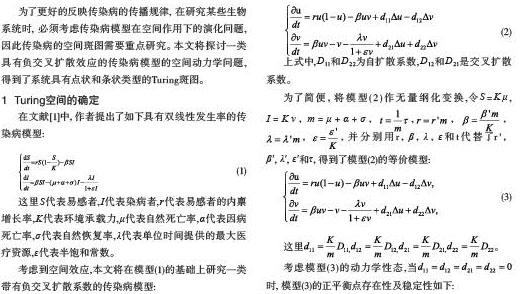一类具有扩散效应的生物数学模型的斑图
2018-10-26徐思奥胡伟张道祥
徐思奥 胡伟 张道祥


摘 要:本文讨论了一类具扩散项的传染病生态模型的空间斑图动力学问题。利用线性稳定性理论确定Turing不稳定和Hopf 分支发生的条件,得到了Turing斑图的存在区域。通过数值模拟,得到了不同类型的Turing斑图,比如点状斑图、条状斑图以及点条混合斑图。结果表明疾病接触率对空间斑图的形成具有重要影响,这帮助我们更好的理解在真实环境中传染病的动力学过程。
关键词:传染病模型 负交叉扩散 Turing斑图
中图分類号:O175.1 文献标识码:A 文章编号:1672-3791(2018)04(b)-0226-03
Abstract: In this paper, we discuss the dynamics of the spatial pattern of the epidemic model with diffusion. Firstly, we determine the conditions of Turing instibility and Hopf bifurcation through the linear stability theorem. And then we obtain the region of Turing pattern. Secondly, some numerical simulations are given to certify different types of Turing patterns, such as spot, stripe and mixture of spot-stripe patterns. The obtained results show negative cross diffusion has great influence on the spatial pattern formation. It helps us better understand the dynamic processes of epidemic in real environment.
Key Words:Epidemic model;Negative cross-diffusion;Turing pattern
为了更好的反映传染病的传播规律, 在研究某些生物系统时, 必须考虑传染病模型在空间作用下的演化问题, 因此传染病的空间斑图需要重点研究。本文将探讨一类具有负交叉扩散效应的传染病模型的空间动力学问题, 得到了系统具有点状和条状类型的Turing斑图。
1 Turing空间的确定
2 数值模拟
3 结语
本文研究了在Neumann边界条件下, 接触率β对具有负交叉扩散效应的传染病模型的影响; 以单位时间提供的最大医疗资源量β为参数, 讨论了Hopf 分支和Turing 分支, 并获得Turing 区域, 所得结果表明:参数β能够对传染病模型的空间斑图产生影响, 随着β在临界处的细微改变, 染病者在空间分布上发生巨大的动力学变化。
参考文献
[1] Li Jinhui,Teng Zhidong,Wang Guangqing,et al.Stability and bifurcation analysis of an SIR epidemic model with logistic growth and saturated treatment[J].Chaos,Solitons,Fractals,2017,99:63-71.
[2] Zheng Qianqian,Shen Jianwei.Pattern formation in the FitzHugh-Nagumo model[J].Computers & Mathematics with Applications,2015,70(5):1082-1097.
[3] 欧阳颀.非线性科学和斑图动力学导论[M].北京:北京大学出版社,2010.
[4] T.D.Frank.Formal derivation of Lotka-Volterra-Haken amplitude equations of Task-Related brain activity in multiple[J].International Journal of Bifurcation and Chaos,2016,26(10):265-274.
[5] Zhao Hongyong,Zhang Xuebing,Huang Xuanxuan.Hopf bifurcation and spatial patterns of a delayed biological economic system with diffusion[J].Elsevier Science Inc,2015,266(C):462-480.
